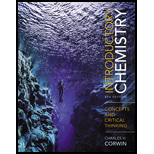
Concept explainers
(a)
Interpretation:
Whether the given substance would sink or float when dropped into water is to be stated.
Concept introduction:
The density is defined as the ratio of mass of a body to its volume. For solid bodies densities are usually expressed in the units of grams per cubic centimeter, for liquids in the units of grams per milliliter and for gases in units of grams per liter.
(b)
Interpretation:
Whether the given substance would sink or float when dropped into water is to be stated.
Concept introduction:
The density is defined as the ratio of mass of a body to its volume. For solid bodies densities are usually expressed in the units of grams per cubic centimeter, for liquids in the units of grams per milliliter and for gases in units of grams per liter.
Want to see the full answer?
Check out a sample textbook solution
Chapter 2 Solutions
Introductory Chemistry: Concepts and Critical Thinking Plus MasteringChemistry with eText -- Access Card Package
- When a marble is dropped into a beaker of water, it sinks to the bottom. Which is the best explanation?arrow_forwardWhich of the following is a liquid nonmetal under normal conditions: sodium, mercury, -bromine, or sulfur?arrow_forwardWhich of the following represents a chemical change?arrow_forward
- Which of the following is not an example of a homogeneous mixture? Select any that apply: - Sugar completely dissolved into water - Air - Oil and Water - Pure Sodium Chloridearrow_forwardWhich physical state is described as having particles closely packed and held rigidly in position?arrow_forwardAssume the average person needs 75mg of vitamin C per day. If you were to travelacross the Atlantic Ocean (a 50 day voyage), how much (in volume) of your commercialsample would be needed?arrow_forward
- All molecules attract each other to some extent, and the attraction decreases as the distance between particles increases. Base on this idea, which state of matter would you expect has the stronges interaction between particles: solid, liquid or gasses?arrow_forwardPut a pinch of salt and sugar in a glass half filled with water. Stir the mixture to dissolve the solutes. What property of matter did the salt and sugar exhibit?arrow_forwardWhich of the following does the law of conservation of mass not state?arrow_forward
- Using spheres to represent individual atoms, sketch particulate illustrations of a substance as it is heated from the solid to the liquid and to the gaseous state.arrow_forwardaIs the process of boiling water exothermic or endothermic with respect to the water? bA charged object is moved closer to another object that has the same charge. The energy of the system changes. Is it a change in kinetic energy or potential energy? Is the energy changes an increase or a decrease?arrow_forwardCalculate the volume of 125g of the following liquids: a. Sea water (d=1.03g/mL) b. Methyl alcohol (d=0.792g/mL) c. Concentrated sulfuric acid (d=1.84g/mL)arrow_forward
 Chemistry for Today: General, Organic, and Bioche...ChemistryISBN:9781305960060Author:Spencer L. Seager, Michael R. Slabaugh, Maren S. HansenPublisher:Cengage Learning
Chemistry for Today: General, Organic, and Bioche...ChemistryISBN:9781305960060Author:Spencer L. Seager, Michael R. Slabaugh, Maren S. HansenPublisher:Cengage Learning World of Chemistry, 3rd editionChemistryISBN:9781133109655Author:Steven S. Zumdahl, Susan L. Zumdahl, Donald J. DeCostePublisher:Brooks / Cole / Cengage LearningChemistry: Matter and ChangeChemistryISBN:9780078746376Author:Dinah Zike, Laurel Dingrando, Nicholas Hainen, Cheryl WistromPublisher:Glencoe/McGraw-Hill School Pub Co
World of Chemistry, 3rd editionChemistryISBN:9781133109655Author:Steven S. Zumdahl, Susan L. Zumdahl, Donald J. DeCostePublisher:Brooks / Cole / Cengage LearningChemistry: Matter and ChangeChemistryISBN:9780078746376Author:Dinah Zike, Laurel Dingrando, Nicholas Hainen, Cheryl WistromPublisher:Glencoe/McGraw-Hill School Pub Co Introductory Chemistry: An Active Learning Approa...ChemistryISBN:9781305079250Author:Mark S. Cracolice, Ed PetersPublisher:Cengage Learning
Introductory Chemistry: An Active Learning Approa...ChemistryISBN:9781305079250Author:Mark S. Cracolice, Ed PetersPublisher:Cengage Learning Chemistry by OpenStax (2015-05-04)ChemistryISBN:9781938168390Author:Klaus Theopold, Richard H Langley, Paul Flowers, William R. Robinson, Mark BlaserPublisher:OpenStax
Chemistry by OpenStax (2015-05-04)ChemistryISBN:9781938168390Author:Klaus Theopold, Richard H Langley, Paul Flowers, William R. Robinson, Mark BlaserPublisher:OpenStax





